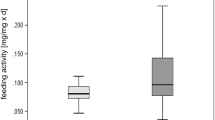Abstract
Freshwater fish (larval lampreysPetromyzon marinus) occupied plastic tubes and ventilated aqueous solutions (around 1.0 mg/L) of the organochlorine pesticide Kepone® at 13°C. The efficiency with which Kepone was extracted from solution during a single pass through the pharynx, and the effect of Kepone on fluxes of Na+ and Cl− across the gills were measured. The efficiency with which lampreys extracted Kepone from local tap water averaged 55–66%, confirmed by measuring Kepone accumulation within the lampreys (as14C-equivalents), using a mass-balance approach. The extraction efficiency matches predictions based on studies using teleosts. Extraction efficiencies declined slowly throughout the exposure period and related inversely to ventilatory rates. In ion-flux measurements, Kepone produced a 40% decline in the rate of influx of Cl− across the pharynx. Effluxes of Na+ and Cl− were not affected, nor was influx of Na+. These latter findings are difficult to reconciliate with accepted theories of Kepone's toxic action; they may relate to the fact that lampreys are unusually tolerant to Kepone poisoning.
Similar content being viewed by others
References
APHA, American Public Health Association (1980) Standard methods for the examination of water and waste-water, 15th edn. APHA-AWWA-WPCF, Washington, DC, pp 356–360
Bender MD, Huggett RJ (1984) Fate and effects of Kepone in the James River. In: Hodgson E (ed) Reviews in Environmental Toxicology, Vol. 1, Elsevier, Amsterdam pp 5–50
Boddington MJ, MacKenzie BA, DeFreitas ASW (1979) A respirometer to measure the uptake efficiency of waterborne contaminants in fish. Ecotoxicol Environ Saf 3:383–393
Boese BL (1984) Uptake efficiency of the gills of English sole (Parophys vetulus) for four phthalate esters. Can J Fish Aquat Sci 41:1713–1718
Cannon SB, Veazey JM Jr, Jackson RS, Burse VW, Hayes C, Straub WE, Landrigan PJ, Liddle JA (1978) Epidemic Kepone poisoning in chemical workers. Am J Epidemiol 107:529–537
Carmines EL, Carchman RA, Borzelleca JF (1979) Kepone: Cellular sites of action. Toxicol Appl Pharmacol 49:543–550
De Renzis G, Maetz J (1973) Studies on the mechanism of chloride absorption by the goldfish gill: Relation with acid-base regulation. J Exp Biol 59:339–358
De Renzis G, Bornancin, M (1984) Ion transport and gill ATPases. In: Hoar WS, Randall DJ (eds) Fish physiology, Vol. 10B Academic Press, New York, pp 65–104
Desiah D (1981) Interaction of chlordecone with biological membranes. J Toxicol Environ Health 8:719–730
Duoll J, Klaassen CD, Amdur MO (1980) Casarett and Doull's Toxicology, 2nd edn, Macmillan, New York, p 636
Eddy FB, Bath RN (1979) Effects of lanthanum on sodium and chloride fluxes in the goldfishCarassius auratus. J Comp Physiol 129:145–149
End DW, Carchman RA, Dewey WL (1981) Neurochemical correlates of chlordecone neurotoxicity. J Toxicol Environ Health 8:707–718
Evans DH (1984) The roles of gill permeability and transport mechanisms in euryhalinity. In: Hoar WS, Randall DJ (eds) Fish physiology, Vol. 10B. Academic Press, New York, pp 239–284
Garcia Romeu F, Maetz J (1964) The mechanism of sodium and chloride uptake by the gills of a fresh-water fish,Carassius auratus. J Gen Physiol 47:1195–1207
Guzelian PS (1982) Comparative toxicology of chlordecone (Kepone) in humans and experimental animals. Ann Rev Pharmacol Toxicol 22:89–113
Hardisty MW (1979) Biology of the cyclostomes. Chapman and Hall, London
Hayton WL, Barron MG (1989) Rate-limiting barriers to xenobiotic uptake by the gill. Environ Toxicol Chem (In Press)
Hobe H, Wood CM, McMahon BR (1984) Mechanisms of acid-base and ionoregulation in white suckers (Castostomus commersoni) in natural soft water. J Comp Physiol B 154:263–272
Kerstetter TH, Kirschner LB (1972) Active chloride transport by the gill of rainbow trout (Salmo gairdneri). J Exp Biol 56:263–272
Kirschner LB (1970) The study of NaCl transport in aquatic animals. Amer Zool 10:365–376
— (1979) Control mechanisms in crustaceans and fishes. In: Gilles A (ed) Mechanisms of osmoregulation in animals. John Wiley & Sons, New York, pp 157–222
Lauren DJ, McDonald DG (1985) Effects of copper on branchial ionoregulation in the rainbow trout,Salmo gairdneri Richardson. J Comp Physiol B 155:635–644
Leadem TP, Campbell RD, Johnson DW (1974) Osmoregulatory responses to DDT and varying salinities inSalmo gairdneri—I. Gill Na-K-ATPase. Comp Biochem Physiol 49A:197–205
Lewis SV (1980) Respiration of lampreys. Can J Fish Aquat Sci 37:1711–1722
Lock RAC, Cruijsen PMJM, van Overbeeke AP (1981) Effects of mercuric chloride and methylmercuric chloride on the osmoregulatory function of the gills in rainbow trout,Salmo gairdneri Richardson. Comp Biochem Physiol 68C:151–159
Mallatt J (1982) Pumping rates and particle retention efficiencies of the larval lamprey, an unusual suspension feeder. Biol Bull 163:197–210
— (1983) Laboratory growth of larval lampreys (Lampetra (Entosphenus) tridentata Richardson) at different food concentrations and animal densities. J Fish Biol 22:293–301
Mallatt J, Barron MG (1988) High tolerance of lampreys to Kepone® toxicity. Arch Environ Contam Toxicol 17:73–80
McDonald DG, Rogano MS (1986) Ion regulation by the rainbow trout,Salmo gairdneri, in ion-poor water. Physiol Zool 59:318–331
McKim JM, Goeden HM (1982) A direct measure of the uptake efficiency of a xenobiotic chemical across the gills of brook trout (Salvenlinus fontinalis) under normoxic and hypoxic conditions. Comp Biochem Physiol 72C:65–74
McKim JM, Heath EM (1983) Dose determinations for waterborne 2,5,2,5′-[14C] tetrachlorobiphenyl and related pharmacokinetics in two species of trout (Salmo gairdneri andSalvelinus fontinalis): A mass-balance approach. Toxicol. Appl Pharmacol 68:17–187
McKim JM, Schmieder P, Veith G (1985) Absorption dynamics of organic chemical transport across trout gills as related to octanol-water partition coefficient. Toxicol Appl Pharmacol 77:1–10
Pritchard JB (1979) Toxic substances and cell membrane function. Federation Proc 38:2220–2225
Rovainen CM, Schieber MH (1975) Ventilation of larval lampreys. J Comp Physiol 104:188–203
Soileau SD, Moreland DE (1988) Effects of chlordecone and chlordecone alcohol on isolated ovine erythrocytes. J Toxicol Environ Health 24:237–249
Stinson CM, Mallatt J (1989) Branchial ion fluxes and toxicant extraction efficiency in lampreys (Petromyzon marinus) exposed to methylmercury. Aquatic Toxicology (In Press)
Author information
Authors and Affiliations
Rights and permissions
About this article
Cite this article
Mallatt, J., Stinson, C. Toxicant extraction efficiency and branchial NaCl fluxes in lampreys exposed to kepone® . Arch. Environ. Contam. Toxicol. 19, 307–313 (1990). https://doi.org/10.1007/BF01054970
Received:
Revised:
Issue Date:
DOI: https://doi.org/10.1007/BF01054970




